Optical Injection Locking for Generation of Tunable Low-Noise Millimeter Wave and THz Signals
Abstract
:1. Introduction
2. Optical Injection Locking for Sub-THz and THz Signal Generation
3. Materials and Methods—Experimental Setups and Employed Lasers
4. Results and Discussion
4.1. Injection Locking with a Single Laser
4.2. Injection Locking with Two Lasers
5. Conclusions
Author Contributions
Funding
Institutional Review Board Statement
Informed Consent Statement
Data Availability Statement
Conflicts of Interest
References
- El Haddad, J.; Bousquet, B.; Canioni, L.; Mounaix, P. Review in terahertz spectral analysis. TrAC Trends Anal. Chem. 2013, 44, 98–105. [Google Scholar] [CrossRef] [Green Version]
- Neu, J.; Schmuttenmaer, C.A. Tutorial: An introduction to terahertz time domain spectroscopy (THz-TDS). J. Appl. Phys. 2018, 124, 231101. [Google Scholar] [CrossRef] [Green Version]
- Cisco, U. Cisco Annual Internet report (2018–2023) White Paper. 2020. Available online: https://www.cisco.com/c/en/us/solutions/collateral/executive-perspectives/annual-internet-report/whitepaper-c11-741490.html (accessed on 26 March 2021).
- Nagatsuma, T.; Ducournau, G.; Renaud, C.C. Advances in terahertz communications accelerated by photonics. Nat. Photonics 2016, 10, 371–379. [Google Scholar] [CrossRef]
- Sengupta, K.; Nagatsuma, T.; Mittleman, D.M. Terahertz integrated electronic and hybrid electronic–photonic systems. Nat. Electron. 2018, 1, 622–635. [Google Scholar] [CrossRef]
- Mehdi, I.; Siles, J.V.; Lee, C.; Schlecht, E. THz diode technology: Status, prospects, and applications. Proc. IEEE 2017, 105, 990–1007. [Google Scholar] [CrossRef]
- Hou, D.; Chen, J.; Yan, P.; Hong, W. A 270 GHz× 9 multiplier chain MMIC with on-chip dielectric-resonator antenna. IEEE Trans. Terahertz Sci. Technol. 2018, 8, 224–230. [Google Scholar] [CrossRef]
- Siles, J.V.; Cooper, K.B.; Lee, C.; Lin, R.H.; Chattopadhyay, G.; Mehdi, I. A new generation of room-temperature frequency-multiplied sources with up to 10× higher output power in the 160-GHz–1.6-THz range. IEEE Trans. Terahertz Sci. Technol. 2018, 8, 596–604. [Google Scholar] [CrossRef]
- Preu, S.; Döhler, G.; Malzer, S.; Wang, L.; Gossard, A. Tunable, continuous-wave terahertz photomixer sources and applications. J. Appl. Phys. 2011, 109, 4. [Google Scholar] [CrossRef] [Green Version]
- Harter, T.; Ummethala, S.; Blaicher, M.; Muehlbrandt, S.; Wolf, S.; Weber, M.; Adib, M.M.H.; Kemal, J.N.; Merboldt, M.; Boes, F.; et al. Wireless THz link with optoelectronic transmitter and receiver. Optica 2019, 6, 1063–1070. [Google Scholar] [CrossRef]
- Shams, H.; Fice, M.J.; Balakier, K.; Renaud, C.C.; van Dijk, F.; Seeds, A.J. Photonic generation for multichannel THz wireless communication. Opt. Express 2014, 22, 23465–23472. [Google Scholar] [CrossRef]
- Koenig, S.; Lopez-Diaz, D.; Antes, J.; Boes, F.; Henneberger, R.; Leuther, A.; Tessmann, A.; Schmogrow, R.; Hillerkuss, D.; Palmer, R.; et al. Wireless sub-THz communication system with high data rate. Nat. Photonics 2013, 7, 977–981. [Google Scholar] [CrossRef]
- Yang, S.H.; Watts, R.; Li, X.; Wang, N.; Cojocaru, V.; O’Gorman, J.; Barry, L.; Jarrahi, M. Tunable terahertz wave generation through a bimodal laser diode and plasmonic photomixer. Opt. Express 2015, 23, 31206–31215. [Google Scholar] [CrossRef] [PubMed]
- Berry, C.W.; Wang, N.; Hashemi, M.R.; Unlu, M.; Jarrahi, M. Significant performance enhancement in photoconductive terahertz optoelectronics by incorporating plasmonic contact electrodes. Nat. Commun. 2013, 4, 1–10. [Google Scholar] [CrossRef] [Green Version]
- Mittleman, D. Sensing with Terahertz Radiation; Springer: Berlin/Heidelberg, Germany, 2013; Volume 85. [Google Scholar]
- Williams, B.S. Terahertz quantum-cascade lasers. Nat. Photonics 2007, 1, 517–525. [Google Scholar] [CrossRef] [Green Version]
- Hübers, H.W.; Eichholz, R.; Pavlov, S.; Richter, H. High resolution terahertz spectroscopy with quantum cascade lasers. J. Infrared Millim. Terahertz Waves 2013, 34, 325–341. [Google Scholar] [CrossRef]
- Ferrero, V.; Camatel, S. Optical phase locking techniques: An overview and a novel method based on single side sub-carrier modulation. Opt. Express 2008, 16, 818–828. [Google Scholar] [CrossRef] [Green Version]
- Balakier, K.; Ponnampalam, L.; Fice, M.J.; Renaud, C.C.; Seeds, A.J. Integrated semiconductor laser optical phase lock loops. IEEE J. Sel. Top. Quantum Electron. 2017, 24, 1–12. [Google Scholar] [CrossRef] [Green Version]
- Morales, A.; Nazarikov, G.; Rommel, S.; Okonkwo, C.; Tafur-Monroy, I. Highly Tunable Heterodyne Sub-THz Wireless Link Entirely Based on Optoelectronics. IEEE Trans. Terahertz Sci. Technol. 2021, 11, 261–268. [Google Scholar] [CrossRef]
- Balakier, K.; Fice, M.J.; van Dijk, F.; Kervella, G.; Carpintero, G.; Seeds, A.J.; Renaud, C.C. Optical injection locking of monolithically integrated photonic source for generation of high purity signals above 100 GHz. Opt. Express 2014, 22, 29404–29412. [Google Scholar] [CrossRef]
- Carpintero, G.; Hisatake, S.; de Felipe, D.; Guzman, R.; Nagatsuma, T.; Keil, N. Wireless data transmission at terahertz carrier waves generated from a hybrid InP-polymer dual tunable DBR laser photonic integrated circuit. Sci. Rep. 2018, 8, 1–7. [Google Scholar] [CrossRef]
- Siegman, A. Lasers; University Science Books: Sausalito, CA, USA, 1986. [Google Scholar]
- Liu, Z.; Slavík, R. Optical injection locking: From principle to applications. J. Light. Technol. 2019, 38, 43–59. [Google Scholar] [CrossRef]
- Albores-Mejia, A.; Kaneko, T.; Banno, E.; Uesaka, K.; Shoji, H.; Kuwatsuka, H. Optical-comb-line selection from a low-power/low-OSNR comb using a low-coherence semiconductor laser for flexible ultra-dense short range transceivers. In Proceedings of the Optical Fiber Communication Conference, Los Angeles, CA, USA, 22–26 March 2015; p. W2A.23. [Google Scholar]
- Liu, Z.; Farwell, S.; Wale, M.; Richardson, D.J.; Slavík, R. InP-based optical comb-locked tunable transmitter. In Proceedings of the Optical Fiber Communication Conference, Anaheim, CA, USA, 20–22 March 2016; p. Tu2K.2. [Google Scholar]
- Kasai, K.; Wang, Y.; Beppu, S.; Yoshida, M.; Nakazawa, M. 80 Gbit/s, 256 QAM coherent transmission over 150 km with an injection-locked homodyne receiver. Opt. Express 2015, 23, 29174–29183. [Google Scholar] [CrossRef]
- Zhou, R.; Shao, T.; Pascual, M.D.G.; Smyth, F.; Barry, L.P. Injection locked wavelength de-multiplexer for optical comb-based nyquist wdm system. IEEE Photonics Technol. Lett. 2015, 27, 2595–2598. [Google Scholar] [CrossRef]
- Fukushima, S.; Silva, C.; Muramoto, Y.; Seeds, A.J. Optoelectronic millimeter-wave synthesis using an optical frequency comb generator, optically injection locked lasers, and a unitraveling-carrier photodiode. J. Light. Technol. 2003, 21, 3043–3051. [Google Scholar] [CrossRef] [Green Version]
- Ng’oma, A.; Fortusini, D.; Parekh, D.; Yang, W.; Sauer, M.; Benjamin, S.; Hofmann, W.; Amann, M.C.; Chang-Hasnain, C.J. Performance of a multi-Gb/s 60 GHz radio over fiber system employing a directly modulated optically injection-locked VCSEL. J. Light. Technol. 2010, 28, 2436–2444. [Google Scholar] [CrossRef]
- Suelzer, J.S.; Simpson, T.B.; Devgan, P.; Usechak, N.G. Tunable, low-phase-noise microwave signals from an optically injected semiconductor laser with opto-electronic feedback. Opt. Lett. 2017, 42, 3181–3184. [Google Scholar] [CrossRef]
- Shortiss, K.; Dernaika, M.; Shayesteh, M.; Peters, F.H. The effect of relaxation oscillations in integrated optical comb demultiplexers based on injection locking. IEEE J. Quantum Electron. 2019, 55, 1–6. [Google Scholar] [CrossRef]
- Bordonalli, A.C.; Fice, M.J.; Seeds, A.J. Optical injection locking to optical frequency combs for superchannel coherent detection. Opt. Express 2015, 23, 1547–1557. [Google Scholar] [CrossRef]
- Yao, J. Microwave photonics. J. Light. Technol. 2009, 27, 314–335. [Google Scholar] [CrossRef]
- Fortier, T.; Baumann, E. 20 years of developments in optical frequency comb technology and applications. Commun. Phys. 2019, 2, 1–16. [Google Scholar] [CrossRef]
- He, C.; Pan, S.; Guo, R.; Zhao, Y.; Pan, M. Ultraflat optical frequency comb generated based on cascaded polarization modulators. Opt. Lett. 2012, 37, 3834–3836. [Google Scholar] [CrossRef]
- Dou, Y.; Zhang, H.; Yao, M. Generation of flat optical-frequency comb using cascaded intensity and phase modulators. IEEE Photonics Technol. Lett. 2012, 24, 727–729. [Google Scholar] [CrossRef]
- Headland, D.; Monnai, Y.; Abbott, D.; Fumeaux, C.; Withayachumnankul, W. Tutorial: Terahertz beamforming, from concepts to realizations. Apl Photonics 2018, 3, 051101. [Google Scholar] [CrossRef] [Green Version]
- Smit, M.; Leijtens, X.; Ambrosius, H.; Bente, E.; Van der Tol, J.; Smalbrugge, B.; De Vries, T.; Geluk, E.J.; Bolk, J.; Van Veldhoven, R.; et al. An introduction to InP-based generic integration technology. Semicond. Sci. Technol. 2014, 29, 083001. [Google Scholar] [CrossRef]
- Kleijn, E.; Smit, M.K.; Leijtens, X.J. Multimode interference reflectors: A new class of components for photonic integrated circuits. J. Light. Technol. 2013, 31, 3055–3063. [Google Scholar] [CrossRef] [Green Version]
- Lau, E.K.; Wong, L.J.; Wu, M.C. Enhanced modulation characteristics of optical injection-locked lasers: A tutorial. IEEE J. Sel. Top. Quantum Electron. 2009, 15, 618–633. [Google Scholar] [CrossRef]
- Tkach, R.; Chraplyvy, A. Phase noise and linewidth in an InGaAsP DFB laser. J. Light. Technol. 1986, 4, 1711–1716. [Google Scholar] [CrossRef]
- Rommel, S.; Dodane, D.; Grivas, E.; Cimoli, B.; Bourderionnet, J.; Feugnet, G.; Morales, A.; Pikasis, E.; Roeloffzen, C.; van Dijk, P.; et al. Towards a scaleable 5G fronthaul: Analog radio-over-fiber and space division multiplexing. J. Light. Technol. 2020, 38, 5412–5422. [Google Scholar] [CrossRef]

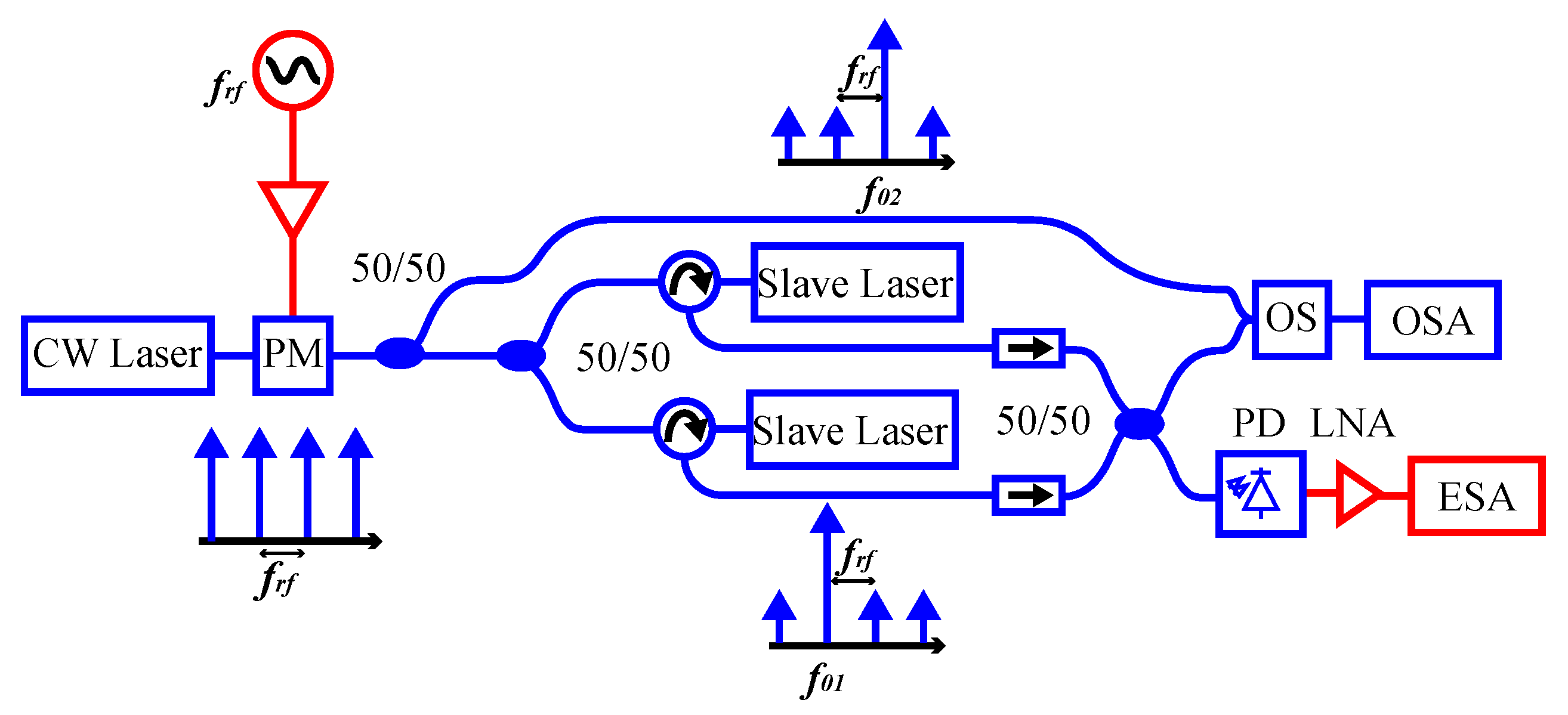



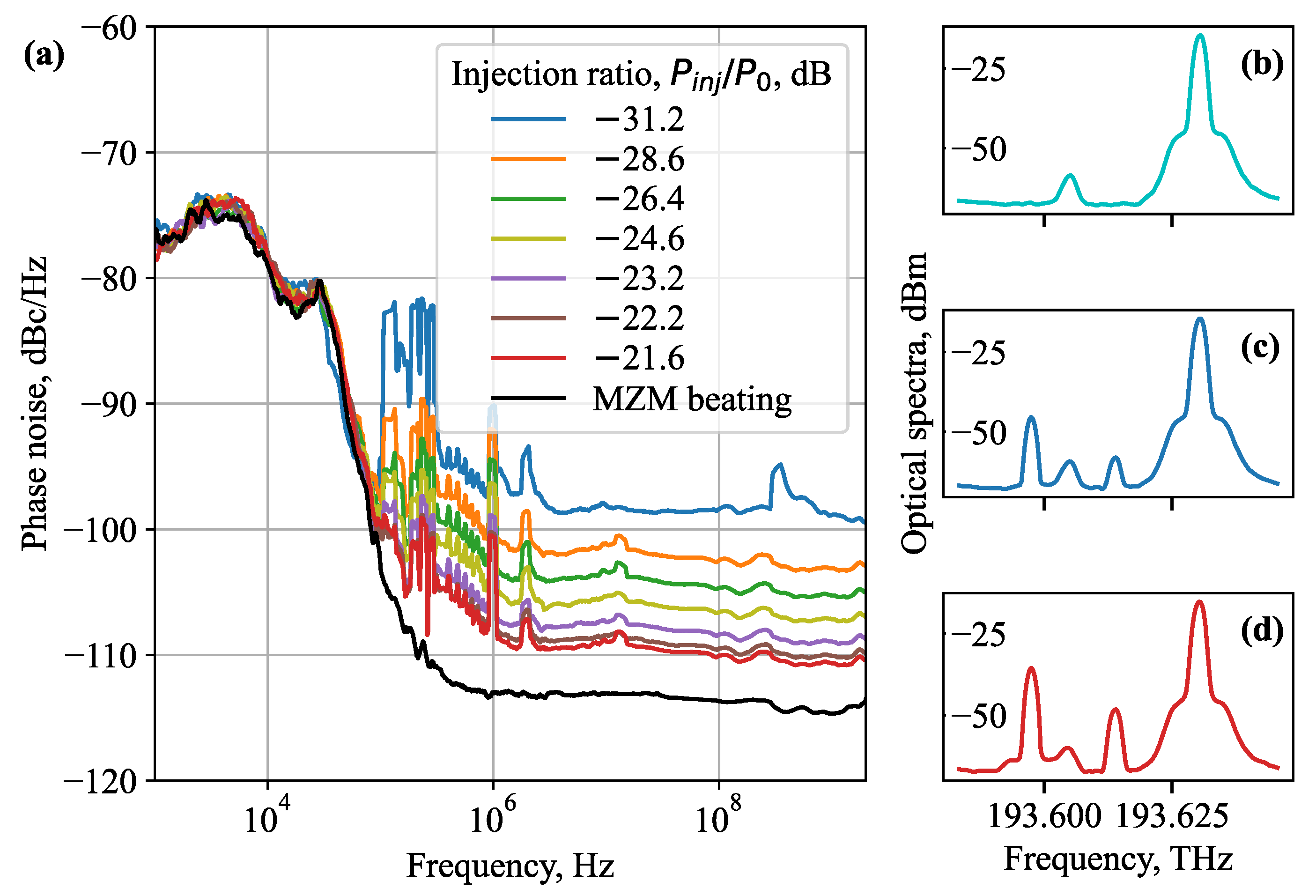
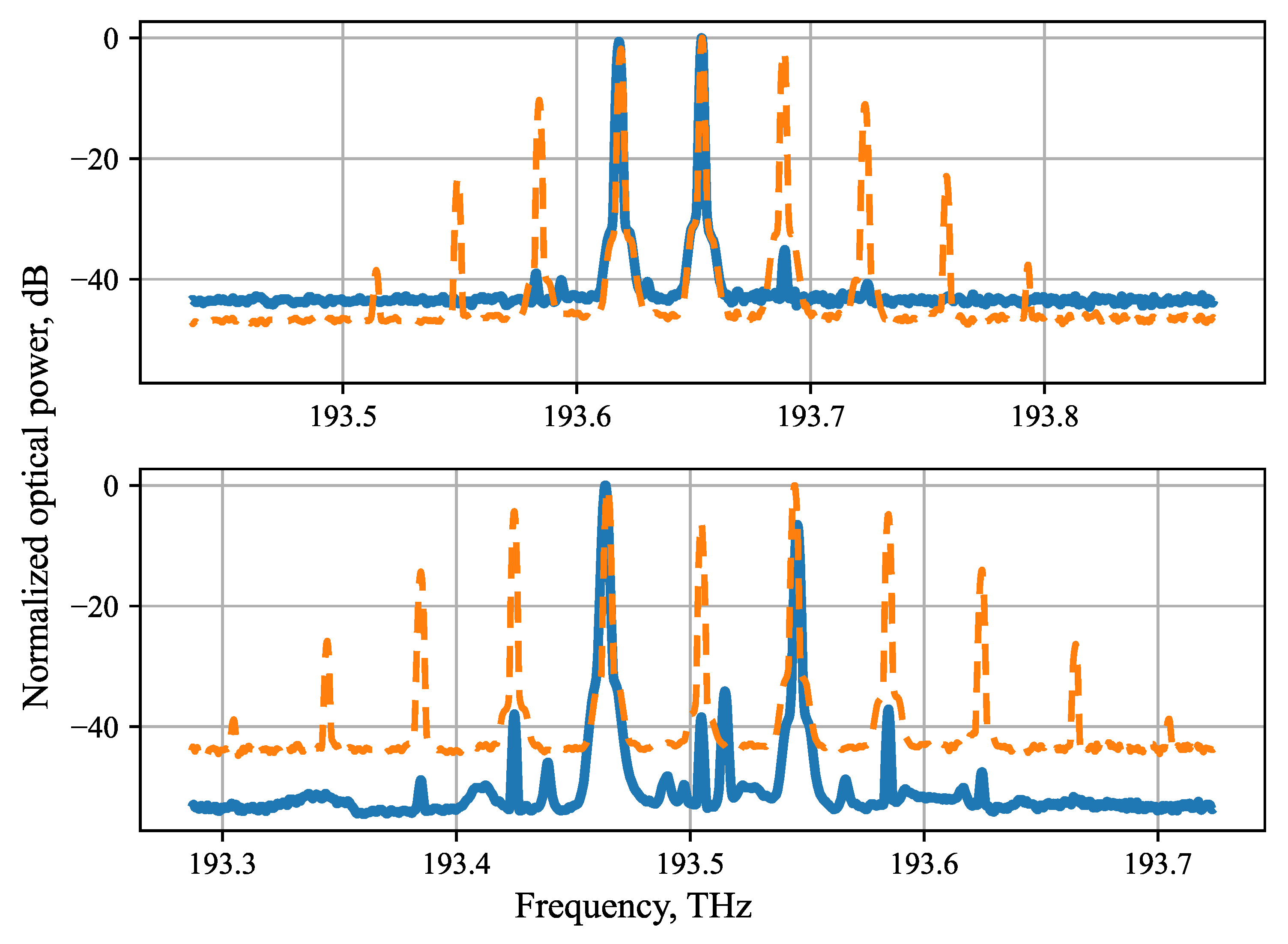
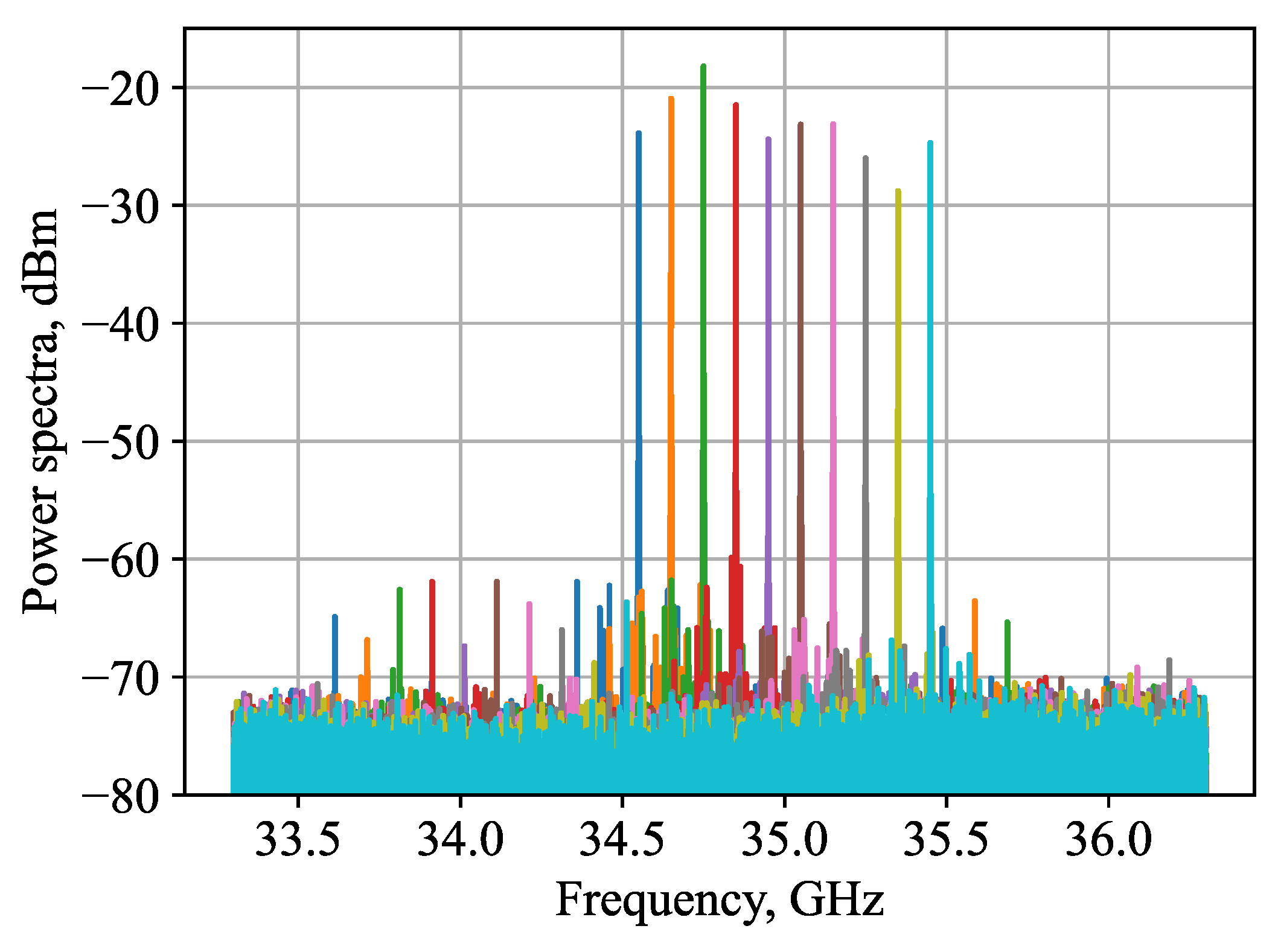
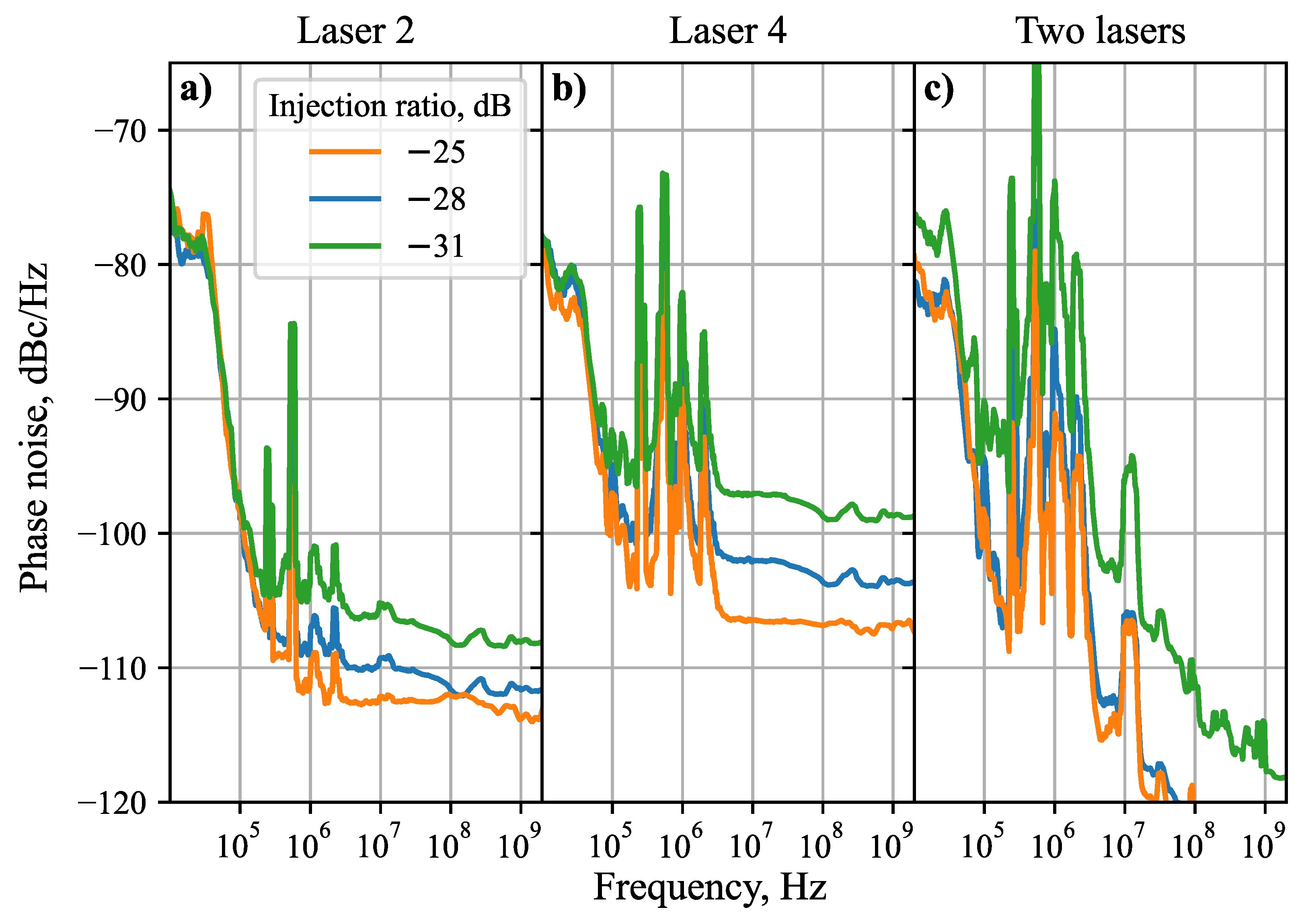
| Laser | DBR, (m) | SOA, (m) | SOA, (m) | PS, (m) | Chip |
|---|---|---|---|---|---|
| Laser 1 | 350 | 500 | 100 | 500 | 1 |
| Laser 2 | 250 | 500 | 100 | 500 | 1 |
| Laser 3 | 250 | 500 | 100 | 500 | 2 |
| Laser 4 | 250 | 400 | 100 | 500 | 2 |
Publisher’s Note: MDPI stays neutral with regard to jurisdictional claims in published maps and institutional affiliations. |
© 2021 by the authors. Licensee MDPI, Basel, Switzerland. This article is an open access article distributed under the terms and conditions of the Creative Commons Attribution (CC BY) license (https://creativecommons.org/licenses/by/4.0/).
Share and Cite
Nazarikov, G.; Rommel, S.; Yao, W.; Tafur Monroy, I. Optical Injection Locking for Generation of Tunable Low-Noise Millimeter Wave and THz Signals. Appl. Sci. 2021, 11, 10185. https://doi.org/10.3390/app112110185
Nazarikov G, Rommel S, Yao W, Tafur Monroy I. Optical Injection Locking for Generation of Tunable Low-Noise Millimeter Wave and THz Signals. Applied Sciences. 2021; 11(21):10185. https://doi.org/10.3390/app112110185
Chicago/Turabian StyleNazarikov, Gleb, Simon Rommel, Weiming Yao, and Idelfonso Tafur Monroy. 2021. "Optical Injection Locking for Generation of Tunable Low-Noise Millimeter Wave and THz Signals" Applied Sciences 11, no. 21: 10185. https://doi.org/10.3390/app112110185
APA StyleNazarikov, G., Rommel, S., Yao, W., & Tafur Monroy, I. (2021). Optical Injection Locking for Generation of Tunable Low-Noise Millimeter Wave and THz Signals. Applied Sciences, 11(21), 10185. https://doi.org/10.3390/app112110185









